四--理性之光与浪漫之声(公开课)PPT课件
- 格式:ppt
- 大小:2.51 MB
- 文档页数:10
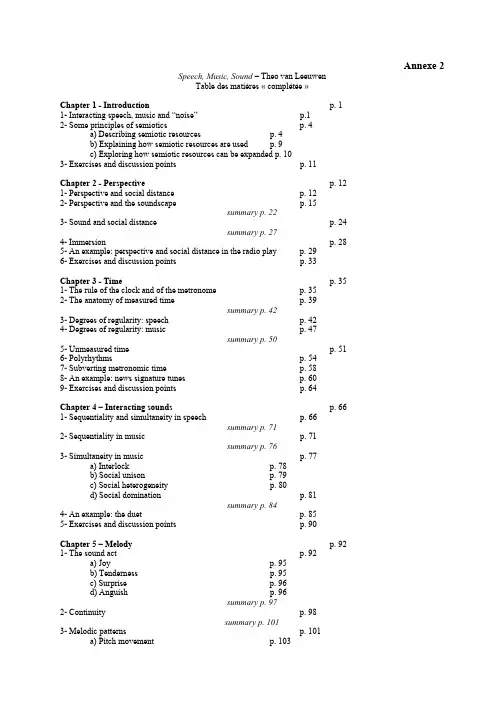
Annexe 2Speech, Music, Sound – Theo van LeeuwenTable des matières « complétée »Chapter 1 - Introduction p. 11- Interacting speech, music and “noise”p.12- Some principles of semiotics p. 4a) Describing semiotic resources p. 4b) Explaining how semiotic resources are used p. 9c) Exploring how semiotic resources can be expanded p. 103- Exercises and discussion points p. 11Chapter 2 - Perspective p. 121- Perspective and social distance p. 122- Perspective and the soundscape p. 15summary p. 223- Sound and social distance p. 24summary p. 274- Immersion p. 285- An example: perspective and social distance in the radio play p. 296- Exercises and discussion points p. 3335Chapter 3 - Time p. 1- The rule of the clock and of the metronome p. 352- The anatomy of measured time p. 39summary p. 423- Degrees of regularity: speech p. 424- Degrees of regularity: music p. 47summary p. 505- Unmeasured time p. 516- Polyrhythms p. 547- Subverting metronomic time p. 588- An example: news signature tunes p. 609- Exercises and discussion points p. 64Chapter 4 – Interacting sounds p. 661- Sequentiality and simultaneity in speech p. 66summary p. 712- Sequentiality in music p. 71summary p. 763- Simultaneity in music p. 77a) Interlock p. 78b) Social unison p. 79c) Social heterogeneity p. 80d) Social domination p. 81summary p. 844- An example: the duet p. 855- Exercises and discussion points p. 90Chapter 5 – Melody p. 921- The sound act p. 92a) Joy p. 95b) Tenderness p. 95c) Surprise p. 96d) Anguish p. 96summary p. 972- Continuity p. 98summary p. 1013- Melodic patterns p. 101a) Pitch movement p. 103b) Pitch range p. 105c) Pitch level p. 107d) The articulation of the melodic phrase p. 109summary p. 1104- Gesture and texture p. 112summary p. 1145- The sonata form p. 1156- Example: a film soundtrack p. 1197- Exercises and discussion points p. 123Chapter 6 – Voice quality and timbre p. 1251- The materiality of sound p. 1252- Dimensions of voice quality and timbre p. 129a) Tense/lax p. 130b) Rough/smooth p. 131c) Breathiness p. 133d) Soft/loud p. 133e) High/low p. 134f) Vibrato/plain p. 134g) Nasality p. 135summary p. 1403- The sounds of speech p. 142a) Frontality p. 146b) Height p. 147c) Aperture p. 147d) Voicing p. 147e) Plosives p. 148f) Fricatives p. 148g) Nasals p. 149h) Semi-vowels p. 149summary p. 1504- An example: the singing voice p. 1505- Exercises and discussion points p. 154Chapter 7 – Modality p. 1571- The idea of modality p. 1572- Naturalism and abstraction in music and film soundtracks p. 1633- The modality of sound p. 170a) Pitch range p. 172b) Durational variation p. 172c) Dynamic range p. 173d) Perspectival depth p. 174e) Degrees of fluctuation p. 175f) Degrees of friction p. 175g) Absorption range p. 176h) Degree of directionality p. 177i) The abstract – sensory coding orientation p. 177j) Naturalistic coding orientation p. 179k) Sensory coding orientation p. 179summary p. 1804- Example: television drama p. 1825- Exercises and discussion points p. 187189Chapter 8 – Afterword p. 1- Metafunctional configurations p. 189a) The ideational metafunction p. 189b) The interpersonal metafunction p. 189c) The textual metafunction p. 1902- Mode, medium and the process of semiosis p. 1913- Making meaning p. 1934- Immersion p. 195 Appendix: System networks and sound scripts p. 198 Glossary p. 203 Bibliography p. 215 Index p. 223Annexe 3 Montage des system networksAnnexe 5 An example, the duetpp. 86 à 89Annexe 6Table of Musematic Occurrence, Philip Tagget Analyse de “Front Row” d’Alanis Morissette, Serge LacasseAnnexe 1 Bibliographie choisie de l’auteur Theo van LeeuwenSrikant Sarangi, Theo Van Leeuwen, British Association for Applied Linguist. Applied Linguistics and Communities of Practice: Selected Papers from the Annual Meeting of the British Association for Applied Linguistics. Cardiff University: Continuum Pub Group, September 2002 (British Studies in Applied Linguistics). (pub. Octobre, 2003).Gunther Kress, Theo Van Leeuwen. Multimodal Discourse: The Modes and Media of Contemporary Communication. Edward Arnold, 2001.Theo Van Leeuwen, Carey Jewitt . Handbook of Visual Analysis. Sage Publications, 2001.Gunther Kress, Theo Van Leeuwen. Reading Images: The Grammar of Visual Design. Routledge, 1996.。
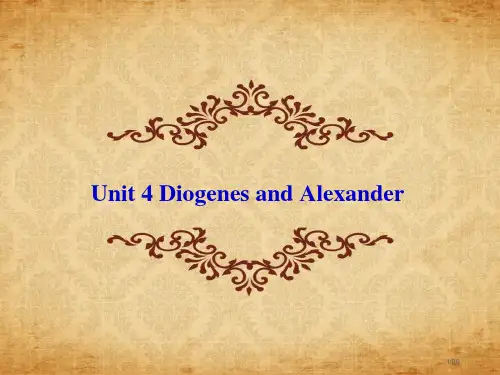
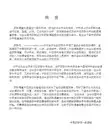


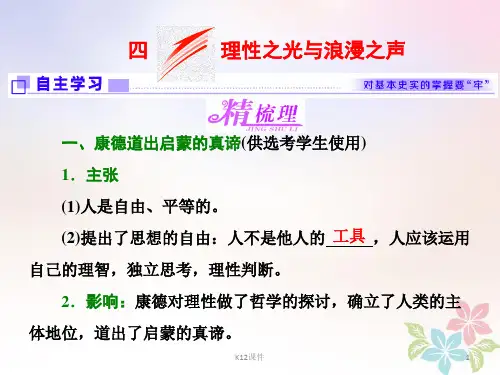

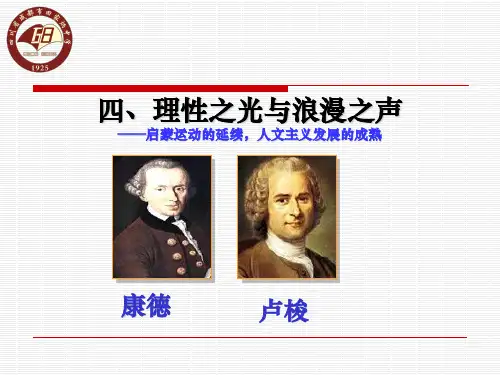

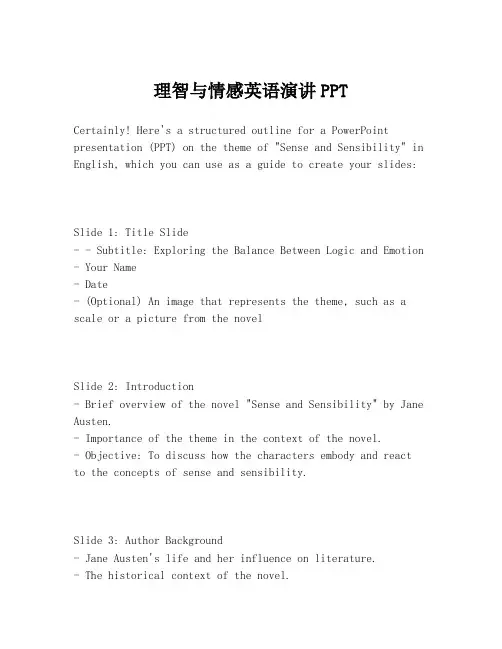
理智与情感英语演讲PPTCertainly! Here's a structured outline for a PowerPoint presentation (PPT) on the theme of "Sense and Sensibility" in English, which you can use as a guide to create your slides:Slide 1: Title Slide- - Subtitle: Exploring the Balance Between Logic and Emotion - Your Name- Date- (Optional) An image that represents the theme, such as a scale or a picture from the novelSlide 2: Introduction- Brief overview of the novel "Sense and Sensibility" by Jane Austen.- Importance of the theme in the context of the novel.- Objective: To discuss how the characters embody and react to the concepts of sense and sensibility.Slide 3: Author Background- Jane Austen's life and her influence on literature.- The historical context of the novel.Slide 4: Plot Summary- A concise summary of the main storyline.- Highlight key events that showcase the theme.Slide 5: Characters and Their Sensibilities- Introduce the main characters: Elinor and Marianne Dashwood. - Describe how Elinor represents 'Sense' and Marianne represents 'Sensibility' (emotion).Slide 6: Elinor's Sense- Discuss Elinor's character traits that reflect her sense.- Provide examples from the novel that illustrate herrationality and self-control.Slide 7: Marianne's Sensibility- Discuss Marianne's character traits that reflect her sensibility.- Provide examples from the novel that illustrate her emotional depth and impulsiveness.Slide 8: Conflict Between Sense and Sensibility- How do the sisters' contrasting approaches to life create conflict within the story?- Discuss key events where their differences are highlighted.Slide 9: Sense and Sensibility in Relationships- Examine the romantic relationships in the novel and how they reflect the theme.- Discuss the outcomes for characters who exhibit either sense or sensibility.Slide 10: Growth and Resolution- How do the characters evolve over the course of the novel? - Discuss how the theme of sense and sensibility is resolved or balanced by the end.Slide 11: Themes and Morals- Beyond sense and sensibility, what other themes does Austen explore?- What moral lessons can be drawn from the novel?Slide 12: Sense and Sensibility in Modern Context- How is the theme of sense and sensibility relevant today?- Discuss parallels between the characters' experiences and modern societal expectations.Slide 13: Conclusion- Summarize the importance of balancing sense and sensibility. - Final thoughts on the novel's impact on literature and society.Slide 14: Questions and Discussion- Invite the audience to ask questions or share theirthoughts on the topic.Slide 15: References- List the sources you've used for your presentation.Remember to keep each slide concise and visually appealing, using bullet points, images, and quotes from the novel to support your points. Good luck with your presentation!。
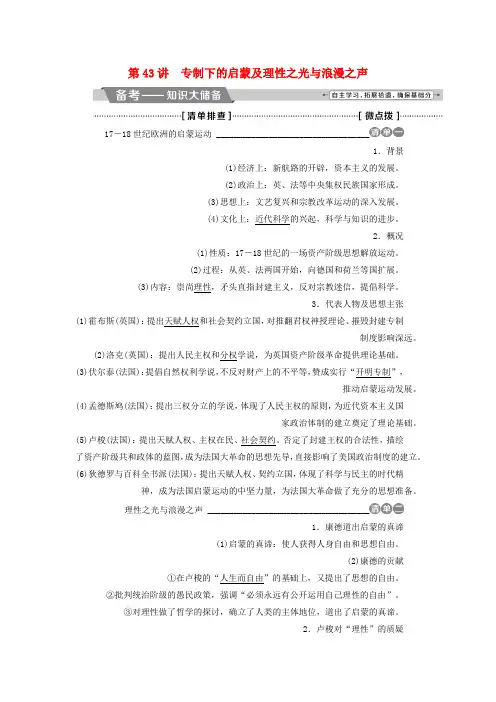
第43讲 专制下的启蒙及理性之光与浪漫之声17-18世纪欧洲的启蒙运动 ___________________________________1.背景(1)经济上:新航路的开辟,资本主义的发展。
(2)政治上:英、法等中央集权民族国家形成。
(3)思想上:文艺复兴和宗教改革运动的深入发展。
科学与知识的进步。
,的兴起近代科学文化上:(4)2.概况(1)性质:17-18世纪的一场资产阶级思想解放运动。
(2)过程:从英、法两国开始,向德国和荷兰等国扩展。
提倡科学。
,反对宗教迷信,矛头直指封建主义,理性内容:崇尚(3)3.代表人物及思想主张对推翻君权神授理论、摧毁封建专制,和社会契约立国天赋人权:提出)英国(霍布斯(1)制度影响深远。
为英国资产阶级革命提供理论基础。
,学说分权:提出人民主权和)英国(洛克(2),”开明专制“赞成实行,不反对财产上的不平等,:提倡自然权利学说)法国(伏尔泰(3)推动启蒙运动发展。
(4)孟德斯鸠(法国):提出三权分立的学说,体现了人民主权的原则,为近代资本主义国家政治体制的建立奠定了理论基础。
描绘,。
否定了封建王权的合法性社会契约:提出天赋人权、主权在民、)法国(卢梭(5)了资产阶级共和政体的蓝图,成为法国大革命的思想先导,直接影响了美国政治制度的建立。
(6)狄德罗与百科全书派(法国):提出天赋人权、契约立国,体现了科学与民主的时代精神,成为法国启蒙运动的中坚力量,为法国大革命做了充分的思想准备。
理性之光与浪漫之声 _____________________________________1.康德道出启蒙的真谛(1)启蒙的真谛:使人获得人身自由和思想自由。
(2)康德的贡献又提出了思想的自由。
,的基础上”人生而自由“在卢梭的①②批判统治阶级的愚民政策,强调“必须永远有公开运用自己理性的自由”。
③对理性做了哲学的探讨,确立了人类的主体地位,道出了启蒙的真谛。
2.卢梭对“理性”的质疑(1)浪漫主义思潮的形成①质疑:认为崇拜理性、把理性视为人类行为和真理的向导是不可靠的,人类天性本善。